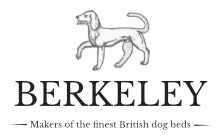It is slowly becoming known that certain materials and treatments used in the manufacture of domestic furniture can be potentially hazardous to our own health and that of our pets. A quick internet search of ‘Toxic Home Syndrome’ will reveal the dangers lurking in our everyday living environment.
So what’s all this got to do with that seemingly innocuous dog bed in the corner of your kitchen, hallway or living room, and why should you care about natural dog beds?
Here’s a few things to consider to start with –
- Dog Beds are almost invariably built to a price point rather than a quality standard. The vast majority are imported from countries which do not uphold the same standards and regulations as our own. Cover a poor quality bed in a cute fabric, stuff it along with many thousands more in a container, price it right and it will fly off the shelf!
- Your dog’s bed is probably the hardest working, most abused piece of furniture in your home. Your dog may lie on it for up to 18 hours per day – It’s scratched, dragged, jumped on and sometimes not vacuumed and/or washed as often as you’d wish. Moreover, it may sometimes become damp and develop mould/mildew and even insect infestations during the course of its often short life before it is consigned to landfill.
- Dogs spend all of their time at floor level – precisely where dust and allergens settle. They are also far more likely to ingest any harmful chemicals down at this level especially when grooming themselves.
Next, let’s have a quick look at a couple of the key constituents commonly found in many current dog bed fillings –
FOAM
Polyurethane Foam is light in weight, easy to cut and shape and does have a soft, bouncy texture – seemingly perfect for the manufacture of dog beds. It’s also incredibly cheap.
Unfortunately, polyurethane breaks down over time through emitting either a fine dust or off-gassing. Just some of the chemicals that we and our pets risk ingesting include Benzene, Formaldehyde, Isocyanates, Toluene, Trichloroethane and Methylene Chloride causing everything from poor fertility, breathing difficulties, skin irritation through to various cancers.
There is a growing trend to use Memory Foam in dog beds – Especially marketed as ‘Orthopaedic’ to cater for senior dogs, dogs with arthritis and other musculoskeletal complaints or for post surgery applications.
It is more expensive, but again, it’s easy to cut and form and, from a dog bed manufacturer’s point of view simplicity itself to make – Just cut to shape, cover and away you go!
Foam can be sourced in solid blocks, egg crate form or in chips but at the end of the day, it is still a polyurethane foam and has the same plus even more potentially toxic chemicals in it. In chip form it is much cheaper but largely ineffective and this heightens the rate of break-down and off-gassing.
There are some serious questions to be asked about the benefits of memory foam but we have covered this in other blog articles.
FIRE RETARDANTS
Foam is a bi-product of the petroleum industry and it is highly flammable. Therefore it is usually offered for general sale with a fire retardant treatment applied either by spraying or immersion. As this treatment is not chemically bonded to the host material it can readily break down and off-gas into the home environment.
There are additional articles in our blog about the potential danger of fire retardants to your family and pets but in summary, the chemical ‘brew’ is generally considered to be highly toxic and linked to infertility, various cancers, hormone disruptions and neurological development issues.
There is also growing concern in some of the scientific community regarding the use of stain guard – type fabric treatments applied in a similar way.
Is it any wonder therefore that, as consumer awareness grows, there is a firm-seated desire to switch to more natural, chemical-free and non-toxic alternative materials to be used in the furniture for ourselves and our pets.
For example, wool is an abundant and under-utilised natural resource available on our doorstep. A superb insulator, it is highly breathable, has excellent moisture-wicking properties, offers a degree of natural ‘bounce’, naturally deters many forms of infestation and can be an effective fire retardant … So why use chemicals?
At Berkeley, we are not fanatical about the Eco / Green argument – We just try to embody the basic ethos in all of our product development and business practices as we believe it makes a great deal of sense.
We are constantly striving to move towards more natural dog beds that are non-toxic and safe for your dog. We recognise however that sometimes there has to be a trade-off between being totally chemical-free and practicality / durability / long term sustainability. As an example, we do use PVC backed polyester for our dog bed covers.as we have yet to find a chemical-free fabric that has adequate water and abrasion resistance needed for our particular application.
Hence, as a business we –
- Always have the comfort and long-term health and well-being of your dog at the forefront of everything we do
- Use natural and / or recycled materials whenever practicable
- Strive to avoid the use of all chemicals which may be harmful to your dog
- Adopt a Buy-British philosophy
- Produce quality products that are built to last and can be recycled to minimise landfill
- Treat both our customers and suppliers as we like to be treated ourselves
…simple really!
 Handmade In the UK
Handmade In the UK

